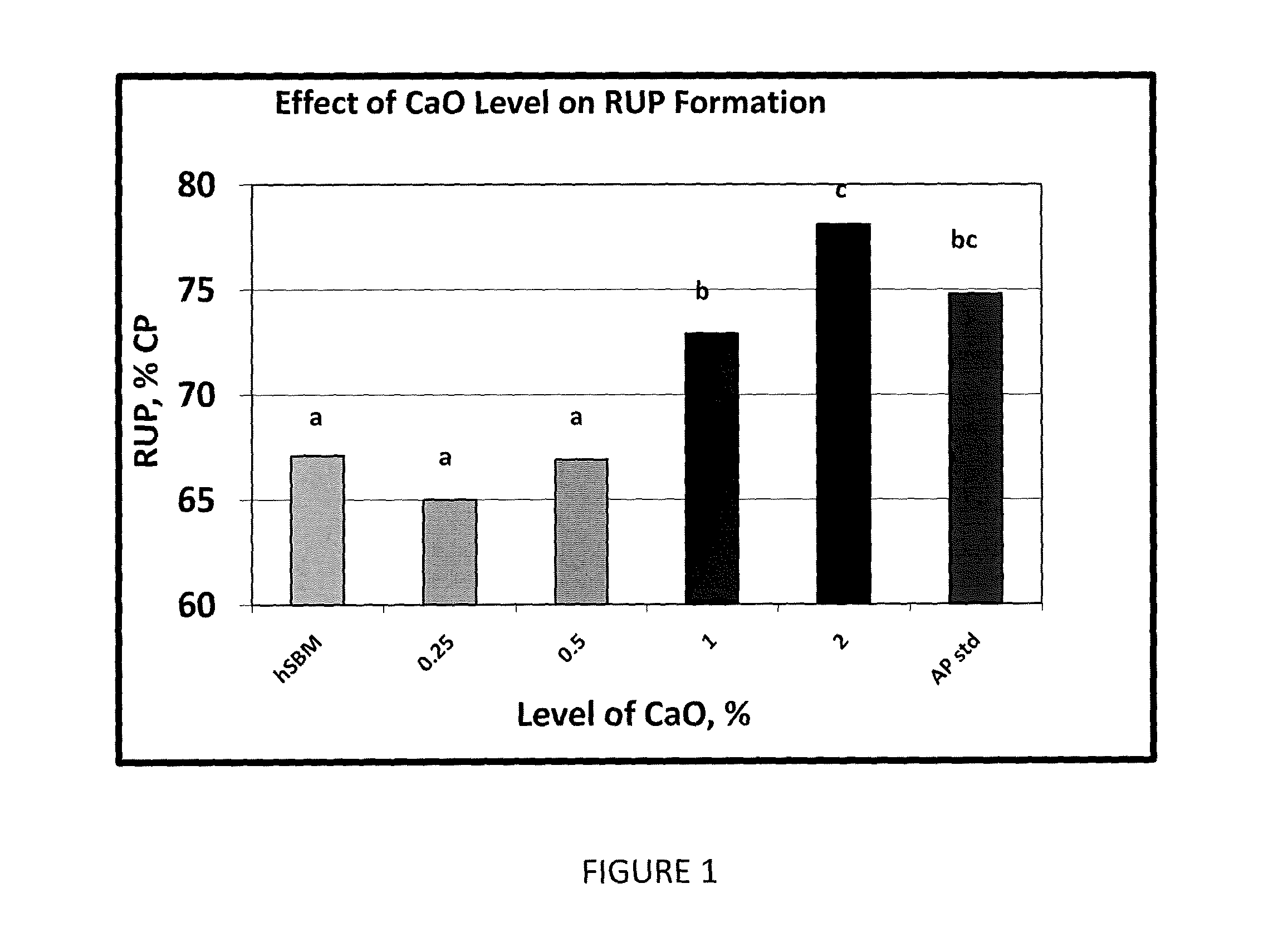Process for modifying protein digestion of ruminant feeds and products produced therefrom
a technology of ruminant feed and protein digestion, which is applied in the field of animal feed composition, can solve the problems that the protein synthesis of rumen fermentation may not meet the animal's demands for metabolizable protein, and increase the demand for rumen bypass protein
- Summary
- Abstract
- Description
- Claims
- Application Information
AI Technical Summary
Benefits of technology
Problems solved by technology
Method used
Image
Examples
example 1
[0045]In this example, the rumen bypass content of soybean meal treated with calcium oxide (CaO) was determined. Samples of soybean meal were mixed for three minutes in a small Hobart mixer with varying amounts of calcium oxide and 25% water (vol / wt). Once mixed, the soybean meal / calcium oxide mixtures were weighed into 8″×8″ glass dishes, covered with aluminum foil, and placed into a 105° C. oven for four hours. After the four hours, the foil was removed, the soybean meal / calcium oxide mixtures were weighed, transferred to a 50° C. oven, dried to 12% moisture and evaluated for rumen undegraded protein content. The calcium oxide was added to the soybean meal samples at 0, 0.25, 0.5, 1.0 and 2.0% on a wt / wt dry matter basis, and all samples were produced on two separate days.
[0046]The results of the calcium oxide treatment on the production of rumen undegraded protein are presented in FIG. 1. There was a linear pattern of increased rumen undegraded protein with increased calcium oxid...
example 2
[0047]In another example, the rumen bypass content of soybean meal treated with calcium oxide, sodium percarbonate and a combination of calcium oxide and sodium percarbonate was determined. Samples of soybean meal were mixed for three minutes in a small Hobart mixer with the following treatments: 1% calcium oxide and 25% water (vol / wt); 1% sodium percarbonate and 25% water (vol / wt); and a combination of 0.5% calcium oxide / 0.5% sodium percarbonate and 25% water (vol / wt). Once mixed, the soybean meal mixtures were weighed into 8″×8″ glass dishes, covered with aluminum foil, and placed into a 105° C. oven for four hours. After the four hours, the foil was removed, the soybean meal mixtures were weighed, transferred to a 50° C. oven, dried to 12% moisture and evaluated for rumen undegraded protein content.
[0048]FIG. 3 shows the effects of the treatments on rumen undegraded protein. Each of the 1% calcium oxide treatment, the 1% sodium percarbonate treatment or the combination thereof in...
example 3
[0049]The effects of calcium oxide on the formation of rumen undegraded protein in soybean meal and canola meal was evaluated. Samples of soybean meal or canola meal were mixed for three minutes in a small Hobart mixer with the following treatments; 0.5% calcium oxide and 25% water (vol / wt); 0.5% calcium oxide and 15% water (vol / wt); 1.0% calcium oxide and 25% water (vol / wt); 1.0% calcium oxide and 15% water; 2.0% calcium oxide and 25% water (vol / wt); 2.0% calcium oxide and 15% water. Once mixed, the soybean meal or canola meal mixtures were weighed into 8″×8″ glass dishes, covered with aluminum foil, and placed into a 105° C. oven for four hours. After the four hours, the foil was removed, the soybean meal and canola meal mixtures were weighed, transferred to a 50° C. oven, dried to 12% moisture and evaluated for rumen undegraded protein content.
[0050]The amount of rumen undegraded protein is shown in FIG. 4. For soybean meal, rumen undegraded protein content increased with increas...
PUM
 Login to View More
Login to View More Abstract
Description
Claims
Application Information
 Login to View More
Login to View More - Generate Ideas
- Intellectual Property
- Life Sciences
- Materials
- Tech Scout
- Unparalleled Data Quality
- Higher Quality Content
- 60% Fewer Hallucinations
Browse by: Latest US Patents, China's latest patents, Technical Efficacy Thesaurus, Application Domain, Technology Topic, Popular Technical Reports.
© 2025 PatSnap. All rights reserved.Legal|Privacy policy|Modern Slavery Act Transparency Statement|Sitemap|About US| Contact US: help@patsnap.com



